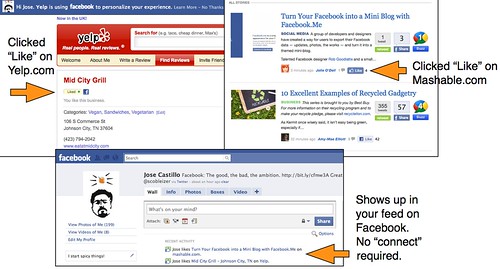The Numbers Behind Facebook’s “Like” Button
 Facebook yesterday posted an analysis of “likers,” those who click the like button on sites using Facebook Friend Connect. This story and Justin Osofsky’s Scrib’d presentation to which it was linked, provided some interesting insights.
Facebook yesterday posted an analysis of “likers,” those who click the like button on sites using Facebook Friend Connect. This story and Justin Osofsky’s Scrib’d presentation to which it was linked, provided some interesting insights.
When the “Like” button is used on an article, that story is added to Facebook’s search database; it is posted to the user’s profile and it is published to a user’s friends, creating three potential avenues for the story to be found by others.
It’s not surprising then, that adding “Like” has substantially increased both usage and engagement on certain sites. News sites like Gawker have seen about a 200% increase in traffic; SimplyHIred.com has experienced 2.2x more job searches and NHL.com users have read 92% more articles. Sites that place friend’s faces next to the “Like” button have a much higher rate of like button usage than those that do not.
Facebook also provided some interesting numbers on “Likers.” The average Facebook user has 130 friends, but people who use the “like” button have more than 2x more friends. They are also over 5x more likely to browse external content. News readers who use the “like” button have a median age about twenty years younger than the average newspaper reader, or 34 and 54. respectively.
Facebook also published guidelines on which kinds of stories increase engagement. On the top of their list were “touching, emotional stories,” for example “fireman adopts girl orphaned in home fire…” and “passionate provocative debates,” for example, “is it time to ban vuvuzuvas?” Both of these types of stories increased engagement by over 2x.
Other recommendations for publishers included: placing the activity plugin above the fold and on multiple pages, using livestream for live events, creating pages on current events, using search API for visualizations that increase engagement. Additional useful recommendations were given to journalists for using Facebook more effectively.
These statistics and guidelines should be quite useful for those seeking to maximize traffic on their sites.